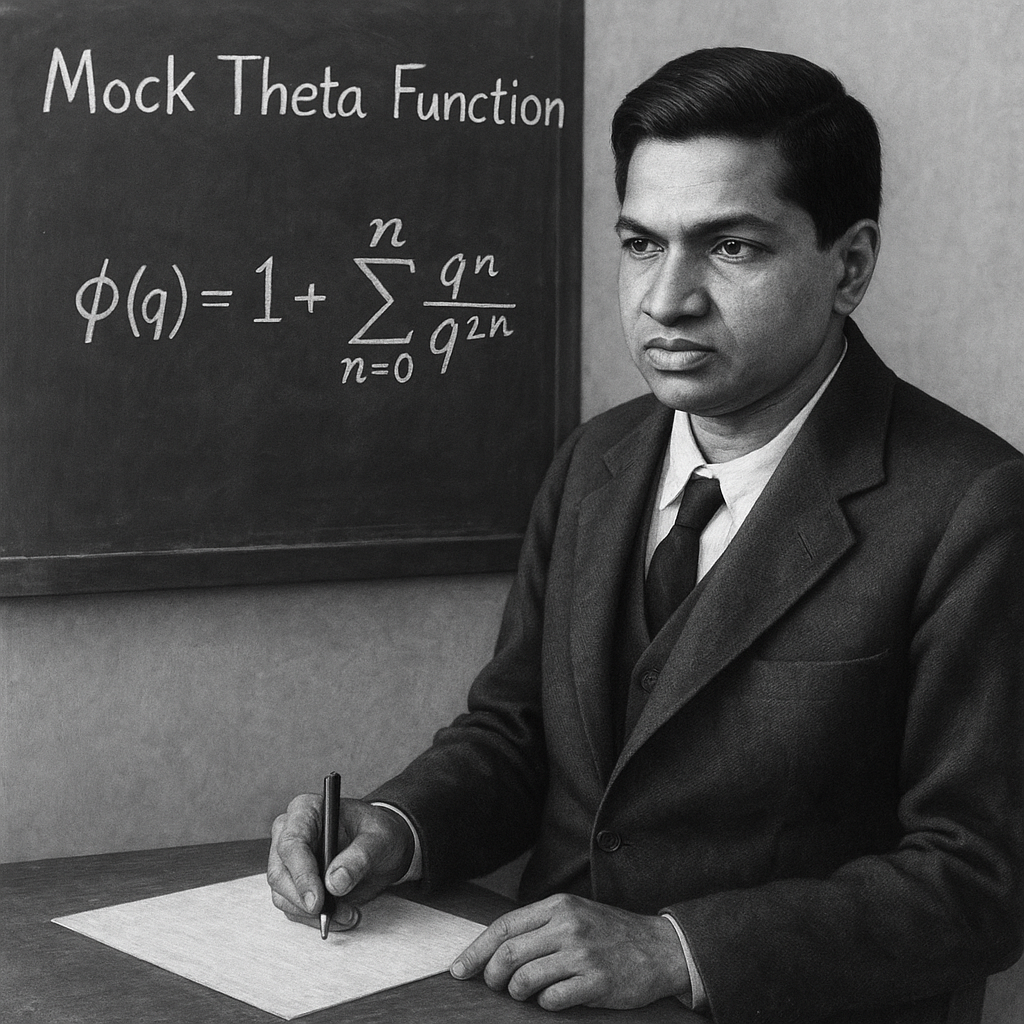Imagine a life where you create formulas out of nowhere that no one understands, only to be proven right decades after your death. That’s Ramanujan’s legacy.
But, leaving behind a legacy isn’t easy. His works, which were in a notebook, was lost after his death. The world lost a major piece of mathematical history, only to be discovered after 50 long years.
The Lost Notebook of Ramanujan is both a mathematical goldmine and a story of mystery and miracles—embodying Ramanujan’s brilliance and the thrill of historical recovery.
So, this article isn’t just about dusty pages of equations—it’s about a story filled with brilliance, spiritual inspiration, vanishing documents, accidental discoveries, and conspiracy theories.
Let’s get started!

The Ramanujan Effect on Human Society
Srinivasa Ramanujan, born in 1887 in India, contributed over 3,900 formulas and identities—many of which were so far ahead of their time that they still baffle mathematicians today.
Without formal training, he developed deep insights in number theory, infinite series, continued fractions, and mathematical analysis. His collaboration with G.H. Hardy revolutionized British mathematics and laid the foundation for key advances in areas like cryptography, computer science, and physics.
Ramanujan’s formulas are now used in string theory, black hole entropy, and quantum field theory. His intuition-driven approach is celebrated not just for its genius, but for the new ways of thinking it introduced—ways that continue to reshape modern science.
The Lost Notebook of Ramanujan: The Mysterious Disappearance
Shortly before Ramanujan died in 1920, he mailed a collection of formulas to G.H. Hardy in England. But what about the rest? What about the notebooks he didn’t send?
After his death, his wife Janaki Ammal passed on various papers to the University of Madras. Some made it to Hardy, some ended up with G.N. Watson, another prominent British mathematician.
When Watson died in 1965, many of his belongings were almost incinerated. By pure luck, a librarian named Robert Rankin retrieved a box of unmarked papers and returned them to Trinity College, Cambridge. For years, no one realized their significance.
Here’s His Full Story: “The Math Wizard” Srinivasa Ramanujan
A Mathematical Indiana Jones Moment: The Discovery
In 1976, mathematician George Andrews of Penn State visited the Wren Library at Trinity College. As he browsed through documents, he stumbled upon a set of 138 pages—handwritten notes filled with wild, unexplained formulas.
He immediately recognized Ramanujan’s handwriting. These pages were unlike any of the three previously known notebooks.
It was a mathematical miracle. Andrews described the discovery as “the Equivalent of Beethoven’s 10th Symphony.”
Together with Bruce Berndt, Andrews spent decades decoding and verifying the formulas. The contents of the Lost Notebook would go on to reshape entire fields of study.
Conspiracy Theories and Speculations
Some believe Ramanujan’s most advanced work was stolen during or shortly after his funeral. Others suggest some documents were hidden or withheld in Madras, never making it to England. The near-destruction of Watson’s possessions only adds to the suspense.
Then there’s the divine element—Ramanujan claimed that the goddess Namagiri would reveal formulas to him in dreams. Could this be literal? Or was it his poetic way of explaining intuition?
Regardless, the narrative blurs the lines between logic, mysticism, and genius.
What We’ve Decoded So Far about The Lost Notebook of Ramanujan?
The Lost Notebook of Ramanujan is packed with mathematical treasures—most without proofs. Here’s what’s been decoded:
- Mock Theta Functions: These strange functions, first mentioned in Ramanujan’s final letter, had no formal definition for decades. Today, they play roles in string theory and quantum physics. They help describe how particles behave at microscopic levels.
- Q-Series and Modular Forms: These are patterns in infinite series—Ramanujan discovered unusual connections that we now understand help explain black hole entropy and data compression.
- New π Formulas and Rapid Convergents: His methods for calculating π were far faster than any known technique at the time and are still used in high-precision calculations.
- Asymptotic Series and Divisor Functions: These ideas help with estimating very large numbers and have uses in number theory and cryptography.
- Hecke Eigenforms and Maass Forms: Deep, abstract objects in mathematics that connect to the structure of the universe. Ramanujan laid the groundwork for these without even knowing it.
Many entries in the notebook remain mysterious. Even now, new papers are being published trying to make sense of his equations. The notebook is an eternal fountain of knowledge.
Why The Lost Notebook of Ramanujan Captivates Us All?
This isn’t just about math. It’s about lost knowledge, recovered genius, near-miraculous preservation, and the sheer power of human intuition. The Lost Notebook of Ramanujan isn’t just a historical artifact—it’s a story that speaks to the soul.
And we’re still deciphering it.
The Last Gift of a Dying Genius: Mock Theta Functions

In the final year of his life, while battling illness in India, Srinivasa Ramanujan wrote a letter to G.H. Hardy. In it, he mentioned something strange—“mock theta functions.”
These functions had never been seen before, had no formal definition, and weren’t part of any known mathematical category. He called them “mock” because they imitated—but weren’t quite—the classical theta functions.
It would take mathematicians nearly 80 years to begin understanding what he meant —and they now show up in black hole physics.
What Are Mock Theta Functions?
Imagine a musical pattern that sounds like a familiar tune—but there’s a twist in rhythm that makes it unique and haunting. That’s what mock theta functions are to regular theta functions.
- Theta functions are well-behaved, classical mathematical tools often used in physics and number theory.
- Mock theta functions look similar on the surface but behave differently under certain transformations.
These “impostor” functions held hidden structures that weren’t formally understood until the early 2000s, when mathematician Sander Zwegers finally placed them into the modern theory of modular forms.
Why Are They Important?
Ramanujan’s mock theta functions now have real-world applications:
- Quantum physics: They help describe behaviors of particles at small scales.
- Black hole entropy: Physicists use them to calculate the informational content of black holes.
- String theory: They show up in understanding how strings vibrate and behave.
For something written by a man on his deathbed, without proof, this was mind-blowing.
How They Were Recovered From a Forgotten Box?
These functions were just a whisper in Ramanujan’s last letter—until George Andrews stumbled on the Lost Notebook of Ramanujan in 1976 at the Wren Library in Cambridge.
Inside were dozens of mock theta identities, scattered across the pages with no explanations. Mathematicians spent decades proving and classifying them.
It wasn’t until 2002 that they were formally “understood” and placed into the landscape of modern math.
What Makes Them So Mysterious?
- They lie between known mathematical categories.
- Ramanujan had no access to the tools that were later used to define them.
- He discovered them purely from intuition and pattern recognition.
Even today, mathematicians uncover new uses and identities related to mock theta functions. Ramanujan’s legacy is still unfolding.
Final Thoughts: The Lost Notebook of Ramanujan
Ramanujan’s work including Mock theta functions are not just formulas—they are mathematical poems. They represent the mystery of genius, the power of intuition, and the enduring value of ideas ahead of their time.
As his final act: he gave out a list of strange equations with no proof. We now know they describe quantum behavior. We had no idea back then what that shit was.
The man was 100 years ahead. The Enigma!
Also Read -> Ramanujan Summation: Mystic Math of Infinite Series







[…] Also Read: The Lost Notebook of Ramanujan: Beethoven’s 10th Symphony […]
[…] Also Read: The Lost Notebook of Ramanujan: Beethoven’s 10th Symphony […]
can i use this post for my personal blog? I talk about science and DIY. please visit – .com
oh yes. you could obviously use parts of it. do give a plagiarism check.
great info